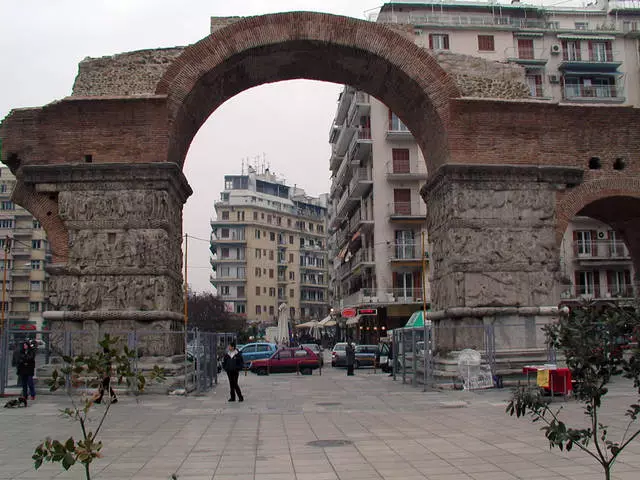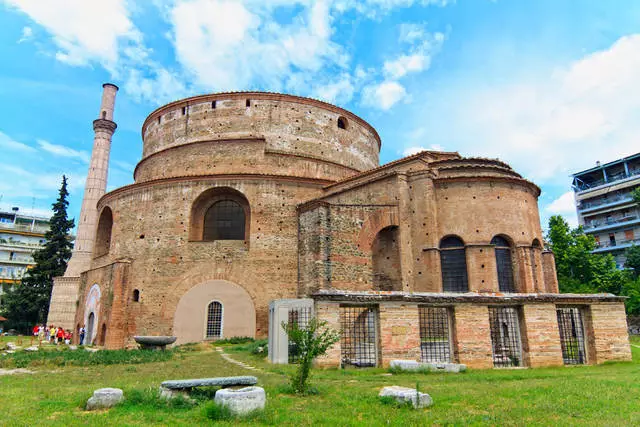To visit the Greek city of Thessaloniki is primarily lovers of antiquities. This city has seen Roman thinkers, and Caesarians, Byzantine emperors and a simple multinational people. Here you will see a large number of vintage buildings - Islamic, Roman buildings, Byzantine Churches ...
A complete list of monuments of the city, which is included in the UNESCO cultural heritage list, is located at this address:
http://whc.unesco.org/en/list/456/multiple=1&unique_number=528
City monuments
Consider the most popular and famous memorable places and religious buildings, which in thessaloniki love to visit visitors.
Triumphal Arch (Camara) in Thessaloniki
The symbol of the city of Thessaloniki is a white tower that snaps over the seaside promenade. In this building, in our time there is a museum where you can see exhibits that are connected with the Byzantine past of the city. This structure was built in about the 1500th year of our era, it performed a protective function for thessalonik.
Triumphal Arch (Caamara) and the Galeria Palace is a monumental architectural ensemble, its ruins are located in our time on the Navarina Square (octagon). The Triumphant Arch of Galery was built in the 305th year of our era, after the emperor defeated Persians, it is a characteristic monument to thessalonik. To this day, survived two major quadrangular columns and one - a minor, which are connected by a brick arch. The main columns are cladding - marble embossed images introduce us to military actions Galery against Persians.

Rotunda
Rotonda is a huge building that has a rounded shape and probably who performed the role of the temple dedicated to Zeus or Couper. A wonderful mosaic has been kept here to this day. Rotonda - the temple of St. George - is located north of Egnatia Street, the merit of her construction belongs to the Emperor Galery, and it happened in the first decade of the fourth century of our era. At first, he should have become a ruler's mausoleum, but to this day it was not used for this purpose, he turned into a Christian church in which the remains of martyrs were honored.

Old market
The activity of the old market has eight centuries - he began working with the birth of the city and existed to the fifth century of our era. This place is the focus of the social and cultural life of the city. Here are the construction of an impressive and majestic species, the most important of them elevated at the end of the third and at the beginning of the fourth centuries. This market was discovered during archaeological studies in 1966. To date, there was a city market, a music school, a mint and room, which most likely performed the function of the urban archive. In addition to all this, a fragment of the Roman bath was also found - with premises for heating and heating furnaces, and other items in large quantities. The old market is located opposite Aristotle Square, if you go to the side opposite to the sea.
Ano Poly (Upper City)
This place is located in the highest part of thessalonik, it is surrounded by the Byzantine walls - they are on the UNESCO World Cultural Heritage Site. The main feature that distinguishes Ano Poly from the rest of the city is the presence of ancient monuments here, which refer to the time from the Byzantine period to the Turkish power. These hundreds of protected buildings are typical examples of antiquity monuments belonging to the traditional Macedonian architecture. By non-searched streets, you can walk to small beautiful areas, where fountains, planenes, vineyards, cafes and taverns are located. In the northern part of the Eastern Wall there is a trigonium tower. In the fifteenth century, she became a replacement of the Byzantine Tower located here, turning into a new building - she used to eighteenth century as a powder and weapon warehouse. The sighting platform near the tower allows you to enjoy a wonderful view of the city. And inside the fortress walls there is a "Sevenbachenic" - this is the Byzantine fort, for many years it was used as a prison.
Monastery Voldadon
The monastery of Nastadon is located on Eptalirgiu Street, close to the walls, and it can be clearly seen here, and a panoramic picture is also open with him. The monastery was built two monks, according to custom, as the monastery Catholicon - in the fourteenth century, with the support of Empress Anna Paleologu. Until our time, only the Catholicon was collected, which is a structure having a vaulted gallery on three sides. Other buildings in the monastery are new. In the temple, which is initially dedicated to Christ's originally, there are unique frescoes. Interesting, in addition, the chapel of Our Lady and the "Cabinet of Igumen". The monastery retained such ancient objects as manuscripts, books, sacred utensils, icons and power of saints. In addition to all this, there are vintage underground tanks here.
The Byzantine churches located in thessaloniki are very interesting - you can see them right in the midst of new high-rise buildings.
Church of St. Dimitri
St. Dimitria, the patron saint of the city, the martyrdom of the death in 303 or 305 of our era. At first, the temple in honor of him was erected at the place of martyrdom (here is now the crypt under the temple sanctuary), in the central part of the Old Town. The first of the temples of St. Dimitri was the chapel, it was founded in the fourth century. The century passed, and the three-throat basil was founded, later burned down - by 630. The bishop erected the next temple - bigger - already a five-fruined basilica - she, in turn, was destroyed by fire in 1917. After that, they carried out work on the restoration, the temple is valid since 1948. Nowadays, you can see here a large amount of mosaics, frescoes and architectural works of the period from the fifth to the fifteenth century. The remains of the saint patron of the city of Thessaloniki rest in a special funeral urn.

Church of St. Sophia
In the Church of St. Sophia, a huge mosaic canvas is kept, which shows the Ascension of Christ, and a mosaic with the image of Our Lady, who sends on the throne and keeps his Christ in the hands of Christ. This building is located in the central part of the city, south from Egnatia Street. The temple was Metropolitan since 1204 and until that time, until he was transformed into Islamic - until 1912, when the time of liberation from Turkish power came.
